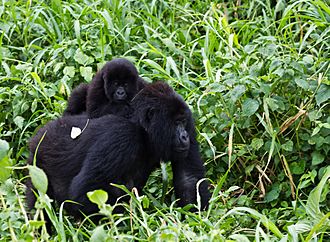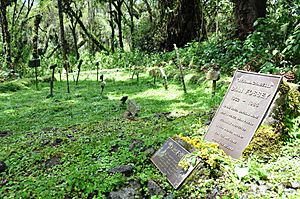Dian Fossey facts for kids
Quick facts for kids
Dian Fossey
|
|
|---|---|
 |
|
| Born | January 16, 1932 San Francisco, California, U.S.
|
| Died | c. December 26, 1985 (aged 53) Volcanoes National Park, Rwanda
|
| Cause of death | Murder |
| Resting place | Karisoke Research Center |
| Alma mater | |
| Known for | Study and conservation of the mountain gorilla |
| Scientific career | |
| Fields | |
| Institutions |
|
| Thesis | The behaviour of the mountain gorilla (1976) |
| Doctoral advisor | Robert Hinde |
| Influences |
|
Dian Fossey (born January 16, 1932 – died December 26, 1985) was an American scientist who studied mountain gorillas. She was also a dedicated conservationist, meaning she worked to protect nature and animals.
From 1966 until her death in 1985, she studied mountain gorilla groups every day. She lived among them in the mountain forests of Rwanda.
Fossey spent 20 years in Rwanda. She worked hard to protect gorillas and their homes. She strongly opposed poaching (illegal hunting) and tourism in gorilla habitats. Her work helped more people understand how smart gorillas are. Her research and conservation efforts helped save mountain gorillas from disappearing.
Contents
Dian Fossey's Early Life
Fossey was born in San Francisco, California. Her parents, Hazel and George Edward Fossey III, divorced when she was six. Her mother remarried a year later.
Dian's stepfather, Richard Price, did not treat her like his own child. This made Fossey feel insecure. She found comfort and acceptance by spending time with animals. Her love for animals started with her first pet goldfish. This love continued throughout her entire life. At age six, she began riding horses. By the time she graduated in 1954, Fossey was a skilled horse rider.
Her Education and First Career
Fossey went to Lowell High School. Her stepfather wanted her to study business. So, she enrolled in a business course at the College of Marin.
However, at age 19, she spent a summer on a ranch in Montana. This trip brought back her love for animals. She then decided to study biology to become a veterinarian at the University of California, Davis.
Fossey wanted to work with animals for her whole life. Her parents did not support her financially. She worked many jobs to pay for her studies. She was a clerk in a department store and a factory worker.
Even though Fossey was usually a good student, she found science subjects like chemistry and physics difficult. She failed her second year of the veterinary program. She then transferred to San Jose State College. There, she studied occupational therapy, which helps people recover from injuries or illnesses. She earned her bachelor's degree in 1954.
Fossey started her career as an occupational therapist. She worked in hospitals in California and with patients who had tuberculosis. In 1955, her love for horses led her to Kentucky. A year later, she took a job at the Kosair Crippled Children's Hospital in Louisville.
Fossey was a shy person, which helped her work well with the children at the hospital. She became good friends with a coworker, Mary White "Gaynee" Henry. The Henrys invited Fossey to their family farm. There, she worked with farm animals every day. She also experienced a warm family life that she had missed. In her free time, she continued to ride horses.
Her Journey to Africa
Fossey wanted to join the Henry family on a trip to Africa, but she did not have enough money. In 1963, she borrowed $8,000 and used all her savings. She went on a seven-week trip to Africa. In September 1963, she arrived in Nairobi, Kenya.
Her safari guide, John Alexander, traveled with her for seven weeks. They visited Kenya, Tanzania, the Democratic Republic of Congo, and Rhodesia (now Zimbabwe).
Two important places she visited were Olduvai Gorge in Tanzania and Mount Mikeno in Congo. At Olduvai Gorge, she learned about the work of Jane Goodall. Goodall was studying chimpanzees and showed the importance of long-term research on great apes.
In Congo, Fossey met wild mountain gorillas for the first time. After her trip, Fossey returned home to Louisville to repay her loans. She wrote three articles for a newspaper about her African adventure.
Researching Gorillas in the Congo
Three years after her first trip, Fossey was invited to start a long-term study of gorillas. This study would be similar to how Jane Goodall studied chimpanzees.
Fossey spent eight months learning Swahili and studying primatology. She also waited for her visa and funding. In December 1966, she arrived in Nairobi. On her way to the Congo, Fossey visited the Gombe Stream Research Centre. She met Jane Goodall there and learned about her research methods with chimpanzees.
Fossey began her study in Kabara, Congo, in early 1967. She found three different gorilla groups in her study area. At first, she could not get close to them. She learned that by copying their actions and making grunting sounds, she could make them feel safe. She also showed submissive behavior and ate local celery plants.
Fossey arrived in the Congo during a time of unrest. On July 9, 1967, soldiers came to her camp. Fossey and her workers were taken to Rumangabo and held for two weeks. Fossey eventually escaped by bribing the guards. The authorities in Uganda advised her not to return to Congo. So, she decided to continue her study in Rwanda.
Conservation Work in Rwanda
On September 24, 1967, Fossey started the Karisoke Research Center. This was a remote camp located in a rainforest in Ruhengeri province, Rwanda. It was nestled between two volcanoes. The camp was about 3,000 meters (9,800 feet) up Mount Bisoke. The study area covered 25 square kilometers (9.7 square miles). Local people called her Nyirmachabelli, which means "The woman who lives alone on the mountain."
The gorillas in the Karisoke area were not used to humans. They only knew humans as poachers. So, it took Fossey longer to study them up close. Fossey tried to get the gorillas used to her by copying their actions. Over time, the gorillas became comfortable with Fossey. She explained to the BBC in 1984: "I'm an inhibited persona and I felt that the gorillas were somewhat inhibited as well, so I imitated their natural, normal behaviour like feeding, munching on celery stalks or scratching myself."
Fossey made many important discoveries about gorillas. She learned how female gorillas move between groups over the years. She also studied gorilla sounds, their social structures, and what they eat. Her research was funded by the Wilkie Foundation, the Leakey Home, and the National Geographic Society.
In 1970, Fossey appeared on the cover of National Geographic Magazine. This brought a lot of attention to her important work.
Fossey was very protective of the gorillas. She was sometimes harsh with Africans who entered the protected area. She even shot at cattle that roamed into the area.
By 1980, Fossey had earned her PhD from Cambridge University in the UK. She was known as the world's top expert on mountain gorillas. She described gorillas as "dignified, highly social, gentle giants, with individual personalities, and strong family relationships." Fossey also taught as a professor at Cornell University from 1981 to 1983.
Many students who came to help with research left. They found it hard to cope with the cold, dark, and very muddy conditions. The paths on the slopes of the Virunga Volcanoes often had to be cut through tall grass with a machete.
Dian Fossey's Death
In the early morning of December 27, 1985, Fossey was found dead in her cabin. Her cabin was at the edge of the camp in the Virunga Mountains, Rwanda. The cabin was messy, with broken glass and overturned furniture.
It seemed like someone had searched her cabin. However, robbery was not the reason for the crime. Fossey's valuable items were still in the cabin. These included her passport, handguns, and thousands of dollars.
The last words in her diary were:
When you realize the value of all life, you dwell less on what is past and concentrate more on the preservation of the future.
Fossey is buried at Karisoke. This is a place she had built for her gorilla friends who had died. She was buried in the gorilla graveyard next to a gorilla named Digit. Many other gorillas killed by poachers are also buried nearby. Memorial services were held for her in New York City, Washington, D.C., and California.
Interesting Facts About Dian Fossey
- She earned her Doctor of Philosophy in Zoology in 1976.
- Fossey held Christmas parties every year for her researchers and staff.
- She became good friends with Jane Goodall, another famous primatologist.
- Fossey would rescue any abused or abandoned animal she found in Africa.
- Many animals lived in her cabin, including a monkey named Kima and a dog named Cindy.
- Fossey was against wildlife tourism. She worried that gorillas could catch human diseases like influenza. However, her research and the attention it brought actually led to "gorilla tourism."
- In 2014, the 82nd anniversary of Fossey's birth was celebrated with a Google Doodle.
- After her death, her Digit Fund in the US was renamed the Dian Fossey Gorilla Fund International.
- The Karisoke Research Center is still run by the Dian Fossey Gorilla Fund International. They continue the daily gorilla monitoring and protection work that she started.
- Gorillas in the Mist, a book published two years before her death, tells the story of her scientific study of gorillas. It was made into a 1988 film of the same name.
- Gorillas in the Mist was praised by Nikolaas Tinbergen, a famous Dutch scientist. Her book is still the best-selling book about gorillas.
- In December 2017, a three-hour series called Dian Fossey: Secrets in the Mist aired on the National Geographic Channel. This series tells her life story, her work, her death, and her lasting impact. It uses old videos, photos, interviews, and new footage.
Images for kids
-
Fossey attended Darwin College at Cambridge.
See also
 In Spanish: Dian Fossey para niños
In Spanish: Dian Fossey para niños





